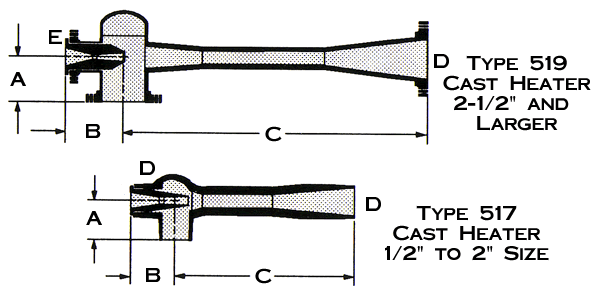Type 517 and Type 519 Steam Jet Heaters |
||||||||||||||||||||||||||||||||||||||||||||||||||||||||||||||||||||||||||||||||||||||||||||||||||||||||
|
Type 517 and Type 519 Steam Jet Heaters have been used successfully in a wide variety of in-line liquid heating applications. Steam jet heaters provide simple and efficient heating of liquids over a capacity range from 3 gpm to 700 gpm. Steam jet heaters also have the ability to pump liquids from atmospheric pressure or below to a pressure intermediate to the suction and motive pressures. Type 517 Heaters are of cast design and are available in 1/2" through 2" sizes. Type 519 Heaters are fabricated in 2-1/2" and larger sizes. Some typical applications include the heating of water, vessel jacket heating, sterilization, and slurry heating. |
||||||||||||||||||||||||||||||||||||||||||||||||||||||||||||||||||||||||||||||||||||||||||||||||||||||||
| PRINCIPLES OF OPERATION | ||||||||||||||||||||||||||||||||||||||||||||||||||||||||||||||||||||||||||||||||||||||||||||||||||||||||
| The steam jet heater utilizes high pressure steam to entrain and heat a lower pressure liquid. The motive steam enters the body of the jet heater through a motive nozzle where the pressure of the steam is converted into a high velocity stream. The high velocity stream creates a vacuum in the body of the jet heater which entrains the suction liquid. Vigorous mixing of the steam and suction liquid takes place in the venturi tail where the steam condenses and heats the liquid stream. As the heated liquid stream enters the diverging section of the venturi tail, the velocity energy is converted to a pressure intermediate to the suction and motive pressures to overcome downstream resistances. | ||||||||||||||||||||||||||||||||||||||||||||||||||||||||||||||||||||||||||||||||||||||||||||||||||||||||
| CONSTRUCTION | ||||||||||||||||||||||||||||||||||||||||||||||||||||||||||||||||||||||||||||||||||||||||||||||||||||||||
| The steam jet heater consists of a one piece body and tail and a removable motive nozzle. It is available in almost any material including carbon steel, stainless steel, Monel, Hastelloy, and titanium. Connections are typically threaded but the unit can be supplied with flanged, butt weld, socket weld, or sanitary connections as required. | ||||||||||||||||||||||||||||||||||||||||||||||||||||||||||||||||||||||||||||||||||||||||||||||||||||||||
|
||||||||||||||||||||||||||||||||||||||||||||||||||||||||||||||||||||||||||||||||||||||||||||||||||||||||
| INSTALLATION AND MAINTENANCE | ||||||||||||||||||||||||||||||||||||||||||||||||||||||||||||||||||||||||||||||||||||||||||||||||||||||||
| Type 517 / 519 Steam Jet Heaters may be installed in any orientation. There are no moving parts, and no routine maintenance is required. Occasional cleaning may be required if the application involves slurries. | ||||||||||||||||||||||||||||||||||||||||||||||||||||||||||||||||||||||||||||||||||||||||||||||||||||||||
 |
||||||||||||||||||||||||||||||||||||||||||||||||||||||||||||||||||||||||||||||||||||||||||||||||||||||||
| Type 517 and 519 Steam Jet Heater Dimensions: | ||||||||||||||||||||||||||||||||||||||||||||||||||||||||||||||||||||||||||||||||||||||||||||||||||||||||
|
||||||||||||||||||||||||||||||||||||||||||||||||||||||||||||||||||||||||||||||||||||||||||||||||||||||||
| 1.Type 517 Heater sizes 1/2" through 2" typically have male pipe thread connections that can be fitted with threaded flanges. | ||||||||||||||||||||||||||||||||||||||||||||||||||||||||||||||||||||||||||||||||||||||||||||||||||||||||
| 2.Type 519 Heater sizes larger than 2" typically have flanged connections. | ||||||||||||||||||||||||||||||||||||||||||||||||||||||||||||||||||||||||||||||||||||||||||||||||||||||||
| Qs = Suction flow of 80°F water in gpm with a 10 foot suction lift and 20 foot discharge head, using 60 psig steam in an LN (Large Nozzle) Heater. | ||||||||||||||||||||||||||||||||||||||||||||||||||||||||||||||||||||||||||||||||||||||||||||||||||||||||
| ** The C dimension may vary in the larger fabricated heaters. | ||||||||||||||||||||||||||||||||||||||||||||||||||||||||||||||||||||||||||||||||||||||||||||||||||||||||
| SIZING EXAMPLE | ||||||||||||||||||||||||||||||||||||||||||||||||||||||||||||||||||||||||||||||||||||||||||||||||||||||||
| For Type 517 / 519 Heater perfomance, please refer to EST Performance Data for Type 417 / 419 Steam Jet Syphons in Bulletin 400. The water temperature increase, AT, in the heater can be calculated using the following equation: | ||||||||||||||||||||||||||||||||||||||||||||||||||||||||||||||||||||||||||||||||||||||||||||||||||||||||
| Water temperature increase, AT,°F = 2 x (Steam Flow in #/hr) / (Water Flow in gpm) | ||||||||||||||||||||||||||||||||||||||||||||||||||||||||||||||||||||||||||||||||||||||||||||||||||||||||
| Problem: | ||||||||||||||||||||||||||||||||||||||||||||||||||||||||||||||||||||||||||||||||||||||||||||||||||||||||
| A Steam Jet Heater is required to heat 80 gpm of 100°F water to 134'F with 5 feet of suction lift and discharge against 10 feet of head using 100 psig pressure steam. What is the heater size, what are the actual steam and water flow rates, and what is the final water temperature? | ||||||||||||||||||||||||||||||||||||||||||||||||||||||||||||||||||||||||||||||||||||||||||||||||||||||||
| Solution: | ||||||||||||||||||||||||||||||||||||||||||||||||||||||||||||||||||||||||||||||||||||||||||||||||||||||||
| From the Performance Data for Type 417 / 419 Steam Jet Syphons in Bulletin 400, a 1" Type 417-LN Syphon handles 20.3 gpm of water using 362 #/hr of 100 psig pressure steam. | ||||||||||||||||||||||||||||||||||||||||||||||||||||||||||||||||||||||||||||||||||||||||||||||||||||||||
| Calculate a capacity ratio as follows: | ||||||||||||||||||||||||||||||||||||||||||||||||||||||||||||||||||||||||||||||||||||||||||||||||||||||||
| 80 gpm /20.3 gpm=3.94 | ||||||||||||||||||||||||||||||||||||||||||||||||||||||||||||||||||||||||||||||||||||||||||||||||||||||||
| Use the next highest capacity ratio of 4 for a 2" Syphon. | ||||||||||||||||||||||||||||||||||||||||||||||||||||||||||||||||||||||||||||||||||||||||||||||||||||||||
| The actual suction water flow will be 4 x 20.3 = 81.2 gpm. | ||||||||||||||||||||||||||||||||||||||||||||||||||||||||||||||||||||||||||||||||||||||||||||||||||||||||
| The steam consumption will be 4 x 362 = 1448 #/hr. | ||||||||||||||||||||||||||||||||||||||||||||||||||||||||||||||||||||||||||||||||||||||||||||||||||||||||
| The temperature increase, AT, will be 2 x (1448 #/hr) / (81.2 gpm) = 35.6°F. | ||||||||||||||||||||||||||||||||||||||||||||||||||||||||||||||||||||||||||||||||||||||||||||||||||||||||
| The final temperature will be 100'F + 35.6'F = 135.6°F. | ||||||||||||||||||||||||||||||||||||||||||||||||||||||||||||||||||||||||||||||||||||||||||||||||||||||||
| Performance conditions may need to be adjusted to achieve the desired temperature rise. | ||||||||||||||||||||||||||||||||||||||||||||||||||||||||||||||||||||||||||||||||||||||||||||||||||||||||
